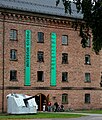Karljohansvern
The Karljohansvern peninsula on the northern edge of Horten ( Norway ) was the headquarters and base ( Karljohansvern Orlogsstasjon, KJV ) of the Royal Norwegian Navy from 1828 to 1962 and is now partly a museum landscape and partly an industrial area. Only the small island of Vealøs with the fortress " Norske Løve ", built in 1852-1859, is still in military possession.
history

The Norwegian Union with Denmark ended with the Peace of Kiel on January 14, 1814 . From the previous Danish- Norwegian Navy, around 125 small warships were transferred to the new Norwegian Navy. In 1818 it was decided to set up a naval base in Horten, on the western bank of the Oslofjord . Two years later, construction began on a shipyard for the construction of warships, the "Horten Verft". The first ship, the frigate Freia , launched on August 25, 1828. When the navy moved its headquarters from Frederiksvern near Larvik to Horten in 1828 , the shipyard was renamed “Marinens Hovedværft”. In 1854 King Oskar I gave her the name "Carljohansværn Værft" in honor of his father, Charles XIV. John of Sweden, the former French Marshal Bernadotte.
In addition to the main shipyard of the navy, there were two fortresses in Karljohansvern (" Norske Løve " on the small island Vealøs to the north and the " Citadellet ", which was blown up and demolished in 1971 ), various naval schools , the naval aircraft factory Marinens Flyvebaatfabrikk and the oldest naval museum founded in 1853 of this kind in the world. At other fortifications there were two beach batteries directed towards the inner harbor, each with eight guns, of which the beach battery No. I, located on the north-western tip of the Kyllinghodet (chicken's head), was destroyed during the expansion of the shipyard, while the beach battery No. II was still partially destroyed exists. In addition, in the years 1870–1879 three more batteries were built for defense in the direction of the Oslofjord, the battery on Moringa, the battery in Tivoli and the battery on the Hortentangen. All three still exist today.
In 1962 the navy moved its headquarters to Haakonsvern near Bergen ; The headquarters of the Eastern Maritime Defense District (Østlandet Sjøforsvarsdistrikt, ØSD) remained in Karljohansvern. The marine shipyard was taken over by the Norwegian state in 1968 and continued under the name Horten Werft A / S (colloquially known as "Verven"), but went bankrupt in 1987 and ceased operations. The area was converted to the Horten Industrial Park (HIP)
After the Eastern Maritime Defense District was dissolved in July 2002, the Officers School of the Coastal Artillery (Befalsskolen for Kystartilleriet, BSKA) in Oscarsborg was merged with the Naval Officer School (Befalsskolen for Marinen, BSMA) and in Karljohansvern as the Naval Officer School (Befalssforskolen for Sø BSS). At the same time, part of the Research Institute for Defense (Forsvarets Forskningsinstitutt) and the Marine Music Corps were quartered here. In August 2010 the BSS was also relocated to Bergen.
Karljohansvern today
Large parts of Karljohansvern have survived unscathed in their historical form, and since 2006 the entire area of the former naval base with its 73 historical buildings has been protected as a historical monument. The area is thus one of a total of ten former fortifications in Norway that are under special protection.
There are two major museums on the site , the Naval Museum and the Norwegian Museum of Photography:
- The Marinemuseum (Marinemuseet) , founded by royal instructions in 1853, houses a number of interesting ships, boats, ship models, weapons and equipment that date back to the Viking Age .
- The Preus Fotomuseum, the Norwegian Museum of Photography created in 1994 by a parliamentary resolution, which also contains the collection of the pre-existing Preus Museum that was bought by Preus As. His collection consists of Norwegian and international photography, cameras and other items that illustrate the history of photography. It also contains a library on photography.
On Karljohansvern there are several bathing beaches on the coast to the Oslofjord and the Hortensskogen forest. Three bridges over the picturesque Horten Canal, which leads from the inner harbor to the yacht harbor on the Oslofjord, connect the peninsula with the city center of Horten, 500 m away.
photos
Notes and individual references
- ↑ The place has been called Stavern since 1830.
Web links
- Karljohansvern Verft, Festningsverkenes utvikling (fortress development); with detailed history and maps (norw.)
- Old postcard photos from Karljohansvern
- http://www.preusmuseum.no/main_karljoh_e.html
Coordinates: 59 ° 25 ′ 37 ″ N , 10 ° 29 ′ 8 ″ E







